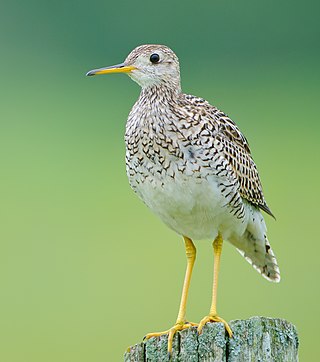
The upland sandpiper is a large sandpiper, closely related to the curlews. Older names are the upland plover and Bartram's sandpiper. In Louisiana, it is also colloquially known as the papabotte. It is the only member of the genus Bartramia. The genus name and the old common name Bartram's sandpiper commemorate the American naturalist William Bartram. The species name longicauda is from Latin longus, "long" and caudus, "tail". The name "Bartram's sandpiper" was made popular by Alexander Wilson, who was taught ornithology and natural history illustration by Bartram.

Stipa is a genus of around 300 large perennial hermaphroditic grasses collectively known as feather grass, needle grass, and spear grass. They are placed in the subfamily Pooideae and the tribe Stipeae, which also contains many species formerly assigned to Stipa, which have since been reclassified into new genera.

The sharp-tailed grouse, also known as the sharptail or fire grouse, is a medium-sized prairie grouse. One of three species in the genus Tympanuchus, the sharp-tailed grouse is found throughout Alaska, much of Northern and Western Canada, and parts of the Western and Midwestern United States. The sharp-tailed grouse is the provincial bird of the Canadian province of Saskatchewan.

The chestnut-collared longspur is a species of bird in the family Calcariidae. Like the other longspurs, it is a small ground-feeding bird that primarily eats seeds. It breeds in prairie habitats in Canada and the northern United States and winters to the south in the United States and Mexico.

Harris's sparrow is a large sparrow. Their breeding habitat is the north part of central Canada, making it Canada's only endemic breeding bird. In the winter they migrate to the Great Plains states of the United States, from southern South Dakota to central Texas. The common name of this species commemorates the American amateur ornithologist Edward Harris (1799–1863).

Bromus hordeaceus, the soft brome, is an annual or biennial species of grass in the true grass family (Poaceae). It is also known in North America as bull grass, soft cheat, and soft chess.
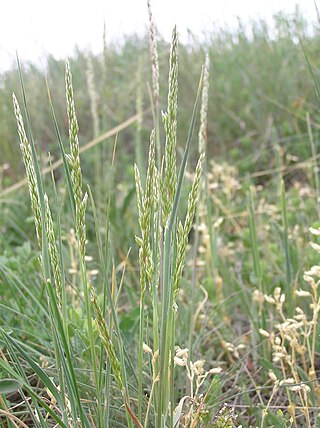
Koeleria macrantha is a species of grass known by the common name prairie Junegrass in North America and crested hair-grass in the UK. It is widespread across much of Eurasia and North America. It occurs in many habitat types, especially prairie.

The native flora of Saskatchewan includes vascular plants, plus additional species of other plants and plant-like organisms such as algae, lichens and other fungi, and mosses. Non-native species of plants are recorded as established outside of cultivation in Saskatchewan, of these some non-native species remain beneficial for gardening, and agriculture, where others have become invasive, noxious weeds. Saskatchewan is committed to protecting species at risk in Canada. The growing season has been studied and classified into plant hardiness zones depending on length of growing season and climatic conditions. Biogeographic factors have also been divided into vegetative zones, floristic kingdoms, hardiness zones and ecoregions across Saskatchewan, and natural vegetation varies depending on elevation, moisture, soil type landforms, and weather. The study of ethnobotany uncovers the interrelation between humans and plants and the various ways people have used plants for economic reasons, food, medicine and technological developments. The Government of Saskatchewan has declared 3 indigenous plants as provincial symbols.

The Lost Forest Research Natural Area is a designated forest created by the Bureau of Land Management to protect an ancient stand of ponderosa pine in the remote high desert county of northern Lake County, in the south central area of the U.S. state of Oregon. Lost Forest is an isolated area of pine trees separated from the nearest contiguous forest land by forty miles of arid desert. There are no springs or surface water in Lost Forest, and much of the southwest portion of the natural area is covered by large shifting sand dunes that are slowly encroaching on the forest.

Sporobolus cryptandrus is a species of grass known as sand dropseed. It is native to North America, where it is widespread in southern Canada, most of the United States, and northern Mexico.
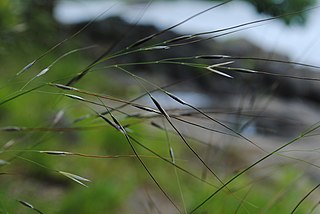
Piptochaetium avenaceum, commonly called black oat grass, blackseed needle grass or blackseed speargrass, is a species of perennial bunchgrass native to eastern North America. It is a member of the grass family Poaceae.

Liatris punctata is a species of flowering plant in the family Asteraceae known by the common names dotted gayfeather, dotted blazingstar, and narrow-leaved blazingstar. It is native to North America, where it occurs throughout the plains of central Canada, the central United States, and northern Mexico.
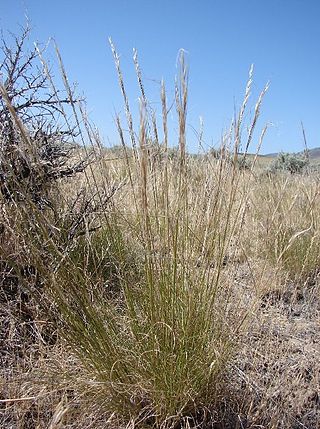
Achnatherum thurberianum is a species of grass known by the common name Thurber's needlegrass. It is native to the western United States, where it occurs from Washington to California and east to Montana and Wyoming.

Calamovilfa longifolia is a species of grass known by the common names prairie sandreed and sand reedgrass. It is native to North America, where it occurs from the Northwest Territories to Ontario in Canada and as far south as New Mexico and Kansas in the United States. There are two varieties, var. longifolia being widespread in the species' range and var. magna being native to the Great Lakes region.

Carex inops is a species of sedge known as long-stolon sedge and western oak sedge. It is native to northern North America, where it occurs throughout the southern half of Canada and the western and central United States.
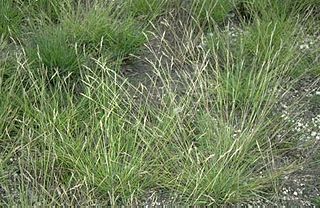
Danthonia spicata is a species of grass known by the common name poverty oatgrass, or simply poverty grass. It is native to North America, where it is widespread and common in many areas. The species is distributed across much of Canada and the United States, and its distribution extends into northern Mexico.

Hesperostipa spartea, formerly Stipa spartea, is a species of grass known by the common names porcupine grass, western porcupine grass, short-awn porcupine grass, porcupine needlegrass, and big needlegrass. It is native to North America, where it is widespread from British Columbia to Ontario in Canada and through the central and Great Lakes regions of the United States. It is a bunchgrass species in the genus Hesperostipa.

Asclepias uncialis is a species of flowering plant in the dogbane family known by the common name wheel milkweed. It is native to the western United States. Two subspecies are sometimes described, with ssp. ruthiae containing three plants which are sometimes described as separate species, Asclepias ruthiae, A. eastwoodiana, and A. sanjuanensis.

The Northern Mixed Grasslands is one of 867 terrestrial ecoregions defined by the World Wide Fund for Nature. This ecoregion includes parts of the Canadian provinces of Alberta, Saskatchewan, and Manitoba, north-central and eastern North Dakota, most of east South Dakota, and north-central Nebraska in the American Great Plains. The United States Environmental Protection Agency (EPA) defines this ecoregion as the Northern Glaciated Plains.





















